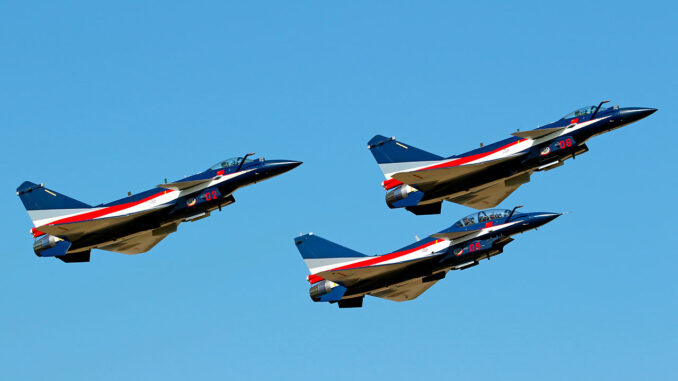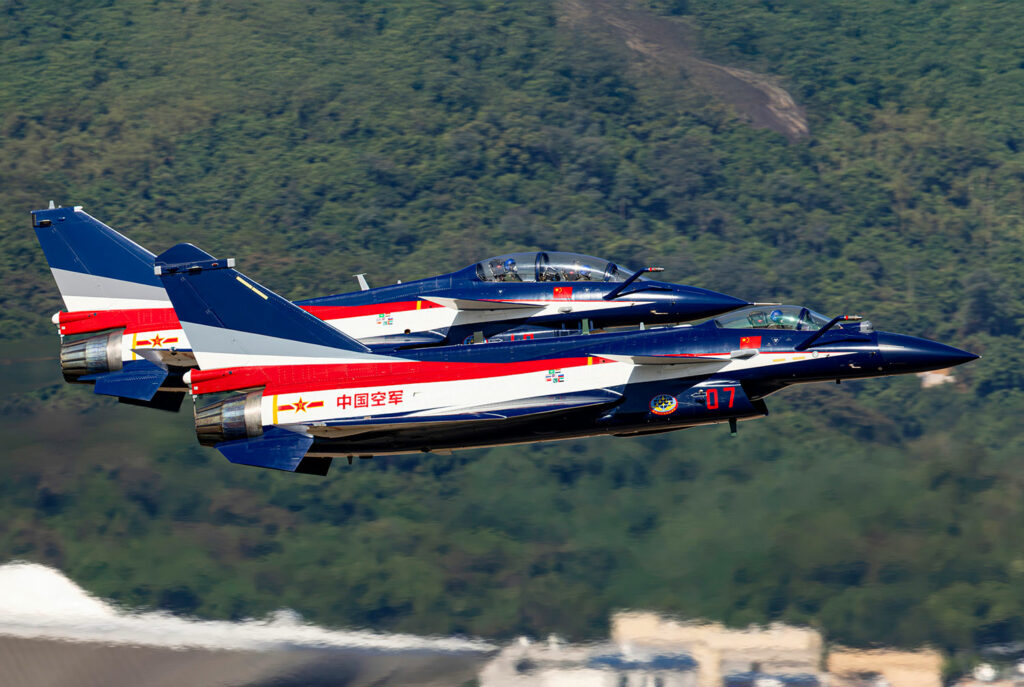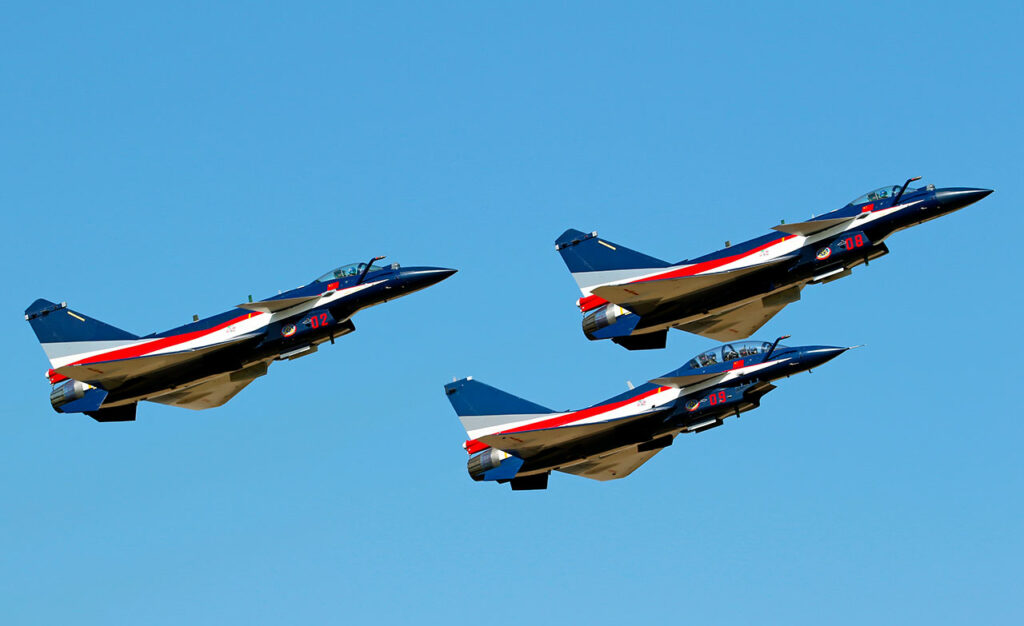
The Chinese J-10C is establishing itself against the F-16 as an integrated alternative, suited to armies wishing to break free from Western standards.
A fighter jet to redefine the balance
The Chengdu J-10C, developed by the Chinese aerospace industry, is now positioned as a credible alternative to the F-16 Fighting Falcon. While the F-16, designed in the 1970s, remains a mainstay of the combat fleets of many US allies, the J-10C is aimed at a different audience: countries seeking operational independence and comprehensive technological solutions without dependence on Western support chains.
Designed as an improved fourth-generation multirole aircraft, the J-10C is part of a broader offering from China. It is not a stand-alone product. It is a complete combat system, with its own radars, munitions, and electronic warfare capabilities. Beijing is banking on a comprehensive approach, whereas the US continues to offer high-performance aircraft that are dependent on a supply chain controlled by Washington.

A response to Western dependence
The Chinese proposal is aimed at countries that are strategically at odds with the West or disagree with the political conditions imposed by the US for the purchase of military equipment. The case of Pakistan is instructive. Since the US restrictions on upgrades to Pakistan’s F-16s and the priority given to India with the offer of the F-21, Islamabad has shifted towards closer cooperation with Beijing.
The J-10C, delivered to the Pakistani Air Force in 2022, has not merely replaced aircraft. It has changed the doctrine of Pakistani military aviation. With its AESA (Active Electronically Scanned Array) radar, long-range PL-15 missiles, and integrated electronic warfare system, it offers capabilities comparable to the F-16V, without the political and logistical constraints of the US.
By replacing the simple purchase of an aircraft with a turnkey offer, China is enabling accelerated commissioning with immediate integration into existing command networks. The result is faster deployment and greater national control over operations.
A targeted export strategy
The J-10 does not sell like Western aircraft. It is not aimed at armies with a powerful industrial base or long-standing institutional partnerships with the US. It targets middle powers with limited budgets but urgent strategic needs. In this configuration, China is adopting a modular approach: customers can combine the J-10 with other platforms such as the JF-17 Block III, designed in partnership with Pakistan, to form a coherent air force.
This strategy is based on two pillars:
- A competitive price (estimated at between $35 million and $45 million per unit, depending on the equipment).
- Reduced dependence on US components, thereby circumventing restrictions on spare parts and maintenance.
Beijing is therefore delivering a product tailored to the operational realities of its customers, within a flexible diplomatic framework, with financing terms often backed by broader bilateral agreements that include infrastructure, training, and political cooperation.
Technical performance to watch
From a technical standpoint, the J-10C is close to recent Western standards. It is equipped with:
- An AESA radar comparable to the AN/APG-83 radar on the F-16V.
- PL-10 and PL-15 air-to-air missiles, with an estimated range of over 200 km for beyond-visual-range engagements.
- A digital cockpit with a head-up display, simplified interface, and tactical data link.
- An integrated electronic warfare system.
Its performance in actual combat has not yet been tested against forces of equivalent strength, but joint exercises with partner countries (Pakistan, Iran, and even Egypt) reveal an aggressive offensive doctrine based on mass effect and radar saturation.
The J-10C is heavier than the F-16, with a maximum takeoff weight of nearly 19 tons, compared to 19.2 tons for the F-16V. Its engine is based on a derivative of the Russian AL-31F engine, pending widespread adoption of the Chinese WS-10, which is less dependent on foreign suppliers.
A deliberate political offensive
China’s objective is not limited to the military market. By promoting the J-10, it is offering an alternative military model that is less subject to Western conditions. Each export becomes a diplomatic tool. Beijing is thus creating long-term strategic dependencies while building China-centric interoperability networks capable of competing with the NATO ecosystem.
This approach also relies on pilot training, standardization of maintenance procedures, and the creation of regional logistics centers. The aim is not to imitate the F-16, but to offer a different standard with its own rules.
This model is attracting certain countries in Africa, Central Asia, and the Middle East, particularly those facing US sanctions or excluded from NATO cooperation systems. The J-10 is therefore becoming a lever for political alignment as much as a military tool.

Challenging Western doctrines
The introduction of the J-10 on foreign markets highlights an implicit criticism of Western air doctrines. Whereas the US favors long and costly modernization cycles, with a dependence on a complex supply chain, China offers an immediate operational solution that can be deployed quickly.
By replacing the incremental modernization model with a capability leap approach, Beijing is attracting countries wishing to catch up militarily without relying on a ten-year partnership. This method is based on the delivery of complete systems, accelerated training, and enhanced autonomy.
In this context, the J-10 is not just an aircraft. It is a strategic Trojan horse, capable of introducing China into the doctrines, equipment, and alliance systems of third countries.
The Chinese J-10C is not superior to the F-16V in every respect. It doesn’t need to be. It just needs to be sufficiently powerful, less politically restrictive, less logistically dependent, and more affordable to be attractive.
In an increasingly fragmented world, the J-10C is part of a comprehensive offering designed for countries that want to build up their air capabilities without joining a Western bloc. It marks a break with the way fighter jets are designed, sold, and deployed.
The duel between the J-10 and the F-16 is therefore not simply a technical comparison. It is a clash between two visions of air power: one integrated into a rigid multilateral order, the other based on a flexible, rapid, and independence-focused bilateral approach.
War Wings Daily is an independant magazine.